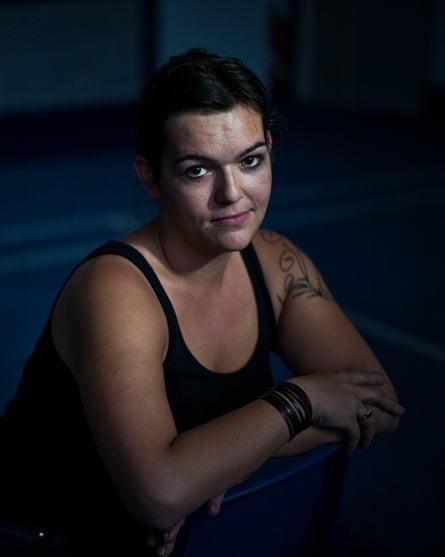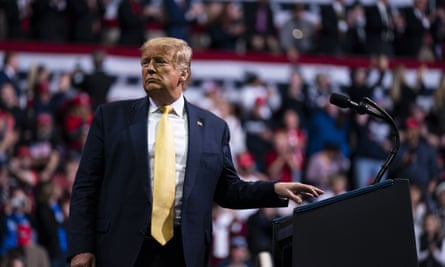A photographer who says she was blinded in one eye. A TV reporter surrounded and arrested by police live on air. A cameraman slammed in the chest with a riot shield while filming a peaceful protest outside the president’s home.
These brutal crackdowns on the media did not take place in a developing world dictatorship. They were in the United States of America, a nation admired around the world for its constitutional right to freedom of speech – but where Donald Trump has spent four years constantly denigrating the media.
During more than a week of demonstrations triggered by the death of George Floyd, an African American man killed by a white Minneapolis police officer who pressed a knee on his neck for nearly nine minutes, journalists covering the story have become targets for both police and protesters in cities across the country, waving their press badges in vain.
The US Press Freedom Tracker, organized by a coalition of press freedom groups, has counted more than 300 incidents since the unrest began: “49+ arrests, 192 assaults (160 by police), 42 equipment/newsroom damage. Assault category breakdown: 69 physical attacks (43 by cops), 43 tear gassings, 24 pepper sprayings, 77 rubber bullets/projectiles.”
Many campaigners find the situation impossible to divorce from Trump’s sustained contempt for the media. He has railed against “fake news” and described the press as “the enemy of the people”.
Suzanne Nossel, chief executive of PEN America, a leading human rights and free expression organisation, said: “You can’t but see the linkage when somebody with such a powerful platform has been relentlessly attacking individual journalists and media outlets and discrediting their reporting so persistently, and then you see members of law enforcement who are actually willing to be caught on film and on camera arresting and attacking members of the media who are doing their job.”
She added: “It’s as if a switch had been turned off in terms of respecting the role of a free press in a democracy.”
Attacks on journalists by protesters, or people who attach themselves to protests, has also been another striking feature of the demonstrations, which have generally been peaceful by day but in some instances marred by violence at night. A crew from Fox News was surrounded by demonstrators outside the White House and jeered at and pelted with objects until they fled. In Atlanta, a crowd stormed the headquarters of CNN.
Nossel added: “Your goal in terms of mounting a forceful demonstration is to capture attention and headlines and television coverage and the media is crucial to that, so for protesters to turn on journalists evinces a real confusion about what it is that keeps our democracy and mechanisms of accountability working.

“The press makes mistakes and misjudgments and that’s a fact, but to think of a working journalist as somehow your enemy, somebody deserving of attack, does reflect this campaign of denigration and discrediting.”
But law enforcement has been by far the main culprit.
In Minneapolis alone, Linda Tirado, a freelance photojournalist and activist who has contributed to the Guardian, said she was now blind in her left eye after being shot at by police; the CNN correspondent Omar Jimenez, who is black, was arrested on live television and released a short time later; Ali Velshi, a host on the MSNBC network, said he was shot in the leg by police firing rubber bullets after his crew identified themselves as journalists.
In Washington, Amelia Brace and Tim Myers were reporting for Australia’s 7News channel outside the White House when they, along with peaceful protesters, were charged by park police and the national guard so Trump could stage a photo op outside a historic church.
With its first amendment guarantee of free speech, America has typically been relied on by journalists, writers and dissidents around the world who face persecution from authoritarian governments. Washington has condemned media repression in Egypt, Turkey and elsewhere. But that moral credibility has been put at risk by a steady deterioration during the Trump era.
In 2018, the US for the first time joined the ranks of the most dangerous countries for journalists to operate, according to the advocacy group Reporters Without Borders. Last week the International Crisis Group, usually preoccupied by global hotspots, warned that racial division risks further “division and instability”.
Speaking from Zimbabwe, Tendai Biti, a human rights lawyer, said he has a 13-year-old son growing up in Maryland. “I’m thinking whether I made the right decision to allow him to go to school in the United States of America because he’s black and it’s obvious there are huge structural issues around race, around inequality, around exclusion which America must deal with,” he said.

“But what’s also shocking is the disproportionate response of the state, if you like, the Africanisation of American politics, the language of exclusion and the language of hate and, of course, what we’ve seen, the exuberant and excessive force used by the authorities.”
Biti, a former political prisoner who served as finance minister in a power-sharing agreement with the then president, Robert Mugabe, added: “For us, who have been fighting autocracies and dictatorship on the African continent, the events in America are giving licence and legitimacy to the authoritarianism and dictatorship and violence that we have seen as democrats for decades.
“Every little tinpot on the African continent is smiling and is studying America’s new copybook plucked from the Democratic Republic of the Congo, from Zimbabwe, from the Central African Republic, from Djibouti.”
The implications for journalists in Africa and elsewhere are profound, Biti added. “Whenever truth becomes a casualty then journalists will suffer. They are mediums of communication, whether it’s newspapers, whether it’s websites, whether it’s social media. In Africa, once, the medium of communication becomes a target, then the messengers become targets and you’ve got a problem.”
Far from toning down his rhetoric, Trump has continued his assault in remarks and tweets. At the end of May he wrote, “The Lamestream Media is doing everything within their power to foment hatred and anarchy,” and called journalists “truly bad people with a sick agenda”. He has not offered any hint that he accepts responsibility for helping create a hostile environment.
Bill Galston, a former policy adviser to President Bill Clinton, said: “I do a lot of reading every day about how the rest of the world is reacting to this and, as an American, it makes me really want to cry. We are the object of scorn from our enemies and pity from our friends. We’ve come to this? At least your country [the UK] has had some decades to get accustomed to the idea of national decline. We’re new to it.”
